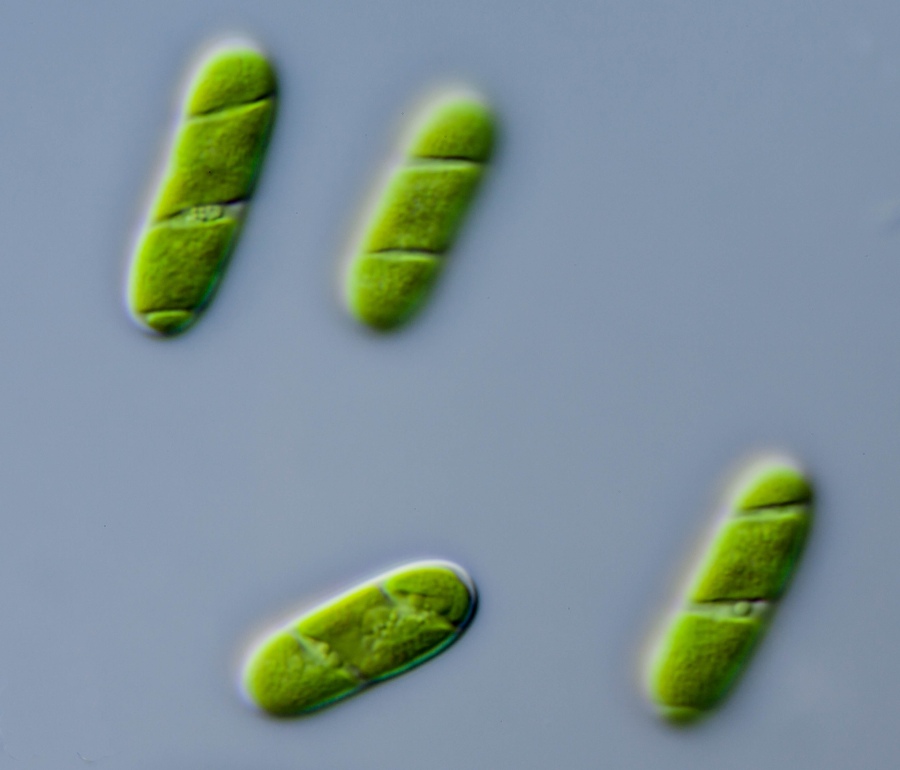By Katie Willis on November 14, 2019 (University of Alberta Press release.)
 |
| A new species of algae called Spirogloea muscicola was also discovered in the course of conducting this research. Image courtesy of Barbara and Michael Melkonian. |
Natural genetic engineering allowed plants to move from water to land, according to a new study by an international group of scientists from Canada, China, France, Germany, and Russia.
“This is one of the most important events in the evolution of life on this planet—without which we as a species would not exist,” said Gane Ka-Shu Wong, co-investigator and professor in the Faculty of Science and Faculty of Medicine & Dentistry at the University of Alberta. “The movement of life from water to land—called terrestrialization—began with plants and was followed by animals and then, of course, humans. This study establishes how that first step took place.”
The movement of plants from water to land was made possible when genes from soil bacteria were transferred to algae through a process called horizontal gene transfer. Unlike vertical gene transfer, such as the transfer of DNA from parent to child, horizontal gene transfer occurs between different species.
Life on land
“For hundreds of millions of years, green algae lived in freshwater environments that periodically fell dry, such as small puddles, river beds, and trickling rocks,” explained Michael Melkonian, professor in the University of Duisburg-Essen in Germany. “These algae mingled with and received key genes from soil bacteria that helped them and their descendants to cope with the harsh terrestrial environment and eventually evolve into the land plant flora that we see today.”
The study is part of an international project focused on sequencing the genomes of more than 10,000 plant species. The discovery was made in the process of sequencing two particular algae, one of them a new species (Spirogloea muscicola) being introduced to the community through this publication.
“The approach that we used, phylogenomics, is a powerful method to pinpoint the underlying molecular mechanism of evolutionary novelty,” said Shifeng Cheng, first author and principal investigator from Agricultural Genome Institute at Shenzhen, Chinese Academy of Agricultural Sciences.
The paper, “Genomes of subaerial Zygnematophyceae provide insights into land plant evolution,” was published in Cell (doi: 10.1016/j.cell.2019.10.019.).
Highlights
• Genomes of two subaerial Zygnematophyceae highlight terrestrial adaptation
• A novel lineage is described that is closest to the origin of embryophytes
• Genes acquired by HGT from soil bacteria regulate plant development and stress
• A recent whole genome triplication is reported for Spirogloea muscicola
Summary
The transition to a terrestrial environment, termed terrestrialization, is generally regarded as a pivotal event in the evolution and diversification of the land plant flora that changed the surface of our planet. Through phylogenomic studies, a group of streptophyte algae, the Zygnematophyceae, have recently been recognized as the likely sister group to land plants (embryophytes). Here, we report genome sequences and analyses of two early diverging Zygnematophyceae ( Spirogloea muscicola gen. nov. and Mesotaenium endlicherianum) that share the same subaerial/terrestrial habitat with the earliest-diverging embryophytes, the bryophytes. We provide evidence that genes (i.e., GRAS and PYR/PYL/RCAR) that increase resistance to biotic and abiotic stresses in land plants, in particular desiccation, originated or expanded in the common ancestor of Zygnematophyceae and embryophytes, and were gained by horizontal gene transfer (HGT) from soil bacteria. These two Zygnematophyceae genomes represent a cornerstone for future studies to understand the underlying molecular mechanism and process of plant terrestrialization.

No comments:
Post a Comment